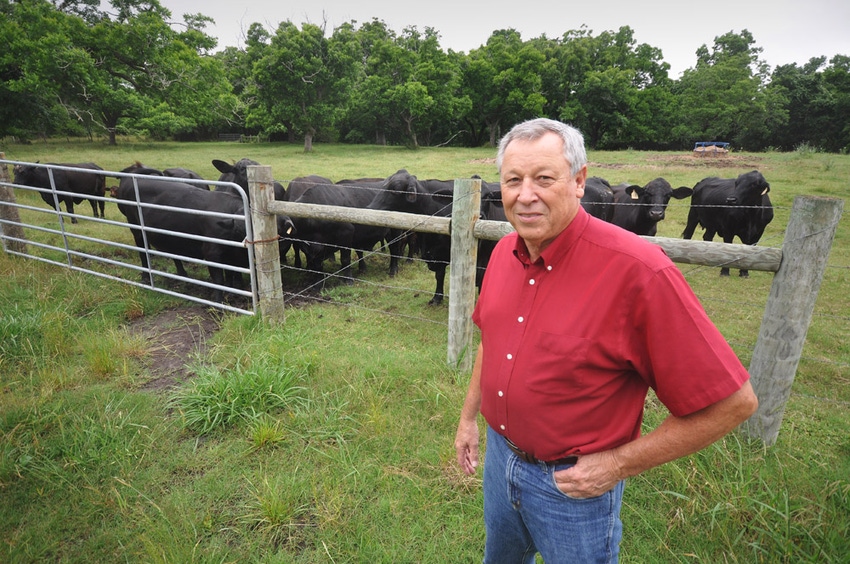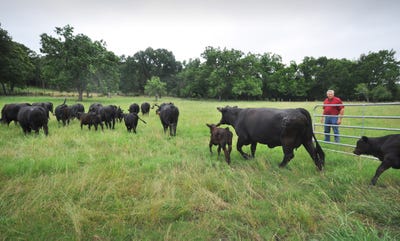Soil health is key in maintaining pasture health.
July 28, 2016

Donnie Dippel has always understood that the name of the game in the cattle business is grass – high-quality grass. But during the past four years, he’s come to understand another important lesson: “You have to work just as hard below ground as you do above ground,” he says.
The realization that productivity above ground is driven by what’s going on below ground has transformed the 65-year-old’s approach to managing his LaGrange, Texas, ranch. Like an increasing number of farmers and ranchers throughout the country, Dippel, who farms 500 acres and raises Brangus cattle, has come to recognize that he also has important livestock below ground.
Those subterranean herds of microorganisms, he understands, are the key to enabling and enhancing the production above it.
Throughout the past several years, Dippel has been learning how best to feed and care for those microorganisms. Working with Willie Durham, a soil health specialist with USDA’s Natural Resources Conservation Service (NRCS), Dipple has implemented a soil health management system that reduces tillage, uses winter cover crops to keep living roots in the soil and he utilizes diverse plant species.
“Everyone just takes it for granted. It’s dirt. It’s just there. No one is thinking about what’s going on in the soil,” Dippel says.
That’s no longer true for Dippel. And while science may not be able to completely explain the elegant symbiosis between soil microorganisms, plants, and the animals feeding upon those plants, Dippel is seeing the positive impacts of managing for soil health on his farm. Those benefits include:
Reduced weed pressure
Improved cattle weight gain
Increased soil organic matter
Lower soil PH levels (in soils with normally high levels)
Increased production on historically lower quality pastures
Reduced need for applying micro-nutrients on pastures
Better overall pasture production and resiliency, especially during dry periods
One of the most important benefits, however, is how cover crops provide additional forage during the winter months when supplemental feeding would normally occur.
“It’s a win-win for us,” Dippel says. “Producing hay is expensive, and by reducing the need for hay, we’re way ahead of the game. A mouth full of green in the winter time goes a long way.”
Dippel says his cows, now grazing on diverse plant species throughout the year, are happier and healthier, too. “We’ve had fewer problems birthing and other health issues. If anything my wife says our cows are too fat.”
A part-time farmer who also manages the Texas Ag Industries Association, Dippel sees growing opportunity for agricultural retailers in the soil health movement.
 “By using cover crops, we’ve been actually able to bring more acres into production,” he says.
“By using cover crops, we’ve been actually able to bring more acres into production,” he says.
And though he’s been able to reduce the application of micro-nutrients on his pastures, he still uses fertilizers as he brings more acres back into production. “We’re not discontinuing the use of fertilizers or herbicides. Our goal is to make better use of what we do use,” he says. “And to understand how everything works as a system.”
But Dippel urges patience as other producers find out what works best on their farms and ranches. He’ll tell you “there’s no one-size-fits-all system” and it takes a little time for the soil’s biologic processes to respond.
“I’ve seen some farmers who put in a cover crop the first year, with only modest results,” he says. “But don’t give up the first year. It gets better every year.”
Dippel admits that some farmers will likely never embrace a farming approach rooted in soil health. They consider it a fad. But Dippel sees it differently.
“It’s not a fad,” he says. “On this farm, it’s the future.”
Ron Nichols is a public affairs officer with the USDA-Natural Resources Conservation Service
You might also like:
4 facts to debunk "Meat is horrible" article
60 stunning photos that showcase ranch work ethics
Best risk strategy options for cattle producers
Does it really take six years to cover your costs on a cow? NO!
Photo Gallery: Get to know the 2016 Seedstock 100 operations
You May Also Like



